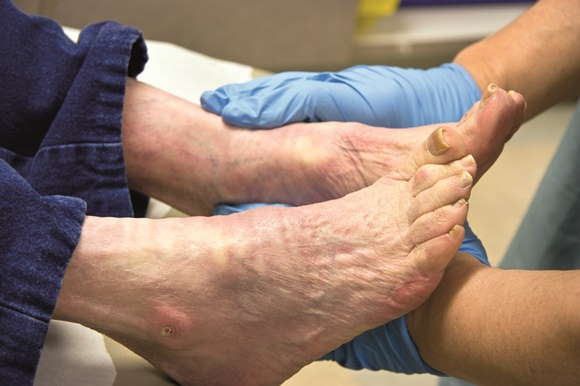What is a foot ulcer?
A foot ulcer is breakdown of the bottom layer of the skin (dermis) on the foot. This full thickness wound or crater provides a direct route to your bloodstream and other deeper structures like bone. Foot ulcers are usually very deep, painful and dangerous. If neglected a foot ulcer will lead to infection and this infection may spread to the bone and other parts of the body.
Signs & Symptoms
- A deep crater or wound on the foot usually in a weight bearing area or area prone to pressure
- Swelling, redness and inflammation around a wound on the foot
- A smelly discharge seeping from a wound on the foot
- Thickened skin or callus around the wound on the foot
- Foot ulcers are usually very painful but some people may not feel them if they have neuropathy (no feeling in their feet)
- In advanced stages of an infected ulcer patients may experience fever and chills
Causes for foot ulcers
Foot ulcers on the feet can be caused by either excess pressure, poor blood supply (arterial) or poor blood flow in veins (venous).
Neuropathic ulcers are pressure ulcers caused in patients who have neuropathy (no feeling in their feet) and can be common in diabetic patients.
Pressure ulcers, which result from large ongoing forces, are most commonly seen by our podiatrists at our podiatry clinic. They are most common over bony and high pressure areas, such as on top of the toes, between the toes and under the forefoot.
Treatment for foot ulcers
Typically treatment involves removing the overlying callus, assessing the wound and providing appropriate dressings and offloading. Our podiatrists take a special interest in this area and our director Nicola has completed post graduate studies in the area of wound management. Nicola is also a consultant podiatrist with NSW Health therefore she routinely provides care to high risk patients with complex limb threatening wounds. This is a specialised area of podiatric medicine.
To heal a foot ulcer our podiatrists will need to address the cause of the ulcer. In the case of pressure ulcers our podiatrists use specific padding, which is applied the foot to offload the affected area and allow for healing. In some cases special splints, insoles or orthotics may also be needed to help an ulcer to heal and to help prevent it from returning.
Ulcers are often a sign of an underlying condition that may not be treated correctly. Speak to your GP about obtaining a referral to a diabetes specialist known as an Endocrinologist who can access your overall health and work closely with our podiatrists to improve your foot health.


